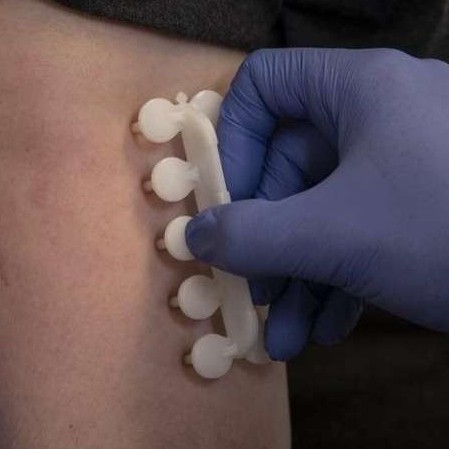As we settle into this final week of October and prepare for some frightful fun at the end of the week, let’s all take a big deep breath in before the end of the year holiday season is upon us! Speaking of that big deep breath, October is Healthy Lung Month and this week, October 24-30 is Respiratory Care Week. This week we focus on the importance of protecting our lungs against infections like bronchitis, allergens such as mold, air pollution and smoking because if we take care of our lungs, our lungs will take care of us.
One of the more impactful allergens on the lungs specifically, is mold. Mold is a type of fungi, and the seeds or spores of the mold travel easily through the air to reproduce and grow. There are many different types of molds, and some spores thrive in dry, windy weather while other spores need damp, humid environments. Although there are many different types of molds, not all mold is responsible for allergic reactions. The most common allergy-causing molds include Alternaria, Aspergillus, Cladosporium and Penicillium.
Mold is unfortunately everywhere, indoors, and outdoors, and is a year-round allergen, although is typically at its highest from July through October or November. Some of the most favorable places for mold growth are on rotting logs or plants, piles of fallen leaves, compost piles, and on grasses or grains. Mold also tends to grow in cool, damp environments indoors such as basements, kitchens, and bathrooms. Tracking symptoms along with exactly where someone has been, can be extremely helpful to a provider trying to determine if mold is an allergen for their patient and the culprit for the troublesome symptoms the patient might be experiencing. Everyone breathes in mold spores on a regular basis, however, those that have an allergy to mold can experience itchy nose, mouth and lips, sneezing, itchy, watery eyes, and nasal symptoms. Those allergic to mold with underlying allergic asthma are especially susceptible to increased wheezing, coughing, chest tightness, or shortness of breath.
With molds living indoors, outdoors, and year-round it might seem overwhelming to figure out how to avoid this troublesome allergen. Similar to pollen counts, mold spore levels in the air are regularly tracked and reported so it is important to check the allergen forecasts and try to limit time outdoors when counts are high. Planning for indoor exposures can be a bit more challenging, however, some spots like greenhouses, farms, flower shops, construction sites, and antique shops are bound to have higher mold spore counts. Plan to take additional allergy medication, avoid during symptom exacerbations or bring a mask to help lower exposures.
Large fields of grains and grasses, and piles of dead, damp leaves are prime places for mold. Avoiding those places is beneficial, and if planning for the young or young at heart to jump in their fall leaf piles, try to plan for a day with low outdoor mold counts if possible. It is important to try to immediately shower after outdoor activities like mowing, or jumping in leaves, especially before crawling into bed. This will help to wash away any allergens that have adhered themselves to your skin or hair and are hoping to enjoy your comfortable accommodations right alongside you. This is especially important before allowing them to have access to your pillow or sheets and being in the immediate space and air you breath in all night.
Finally, and possibly the most important, let’s focus on how to minimize mold existence and exposure in the home environment. As discussed previously, indoor mold tends to prefer damp, humid environments, and areas with high levels of moisture in the air. Consider using a dehumidifier and air conditioners/heating units fitted with high-efficiency particulate air (HEPA) filters. It is best to try to keep humidity below 60%, ideally between 35% and 50%, and that can be easily tracked with a humidity meter available at a low cost at most hardware stores. Mold can thrive in warm, damp bathrooms and humid kitchens. If the kitchen or bathroom has an exhaust fan, use it, especially when taking a shower or bath. This will help to further reduce humidity in these rooms.
Clean surfaces do not provide a conducive environment for mold spore attachment and reproduction however soap scum in the bathroom or grease in the kitchen do provide an inviting area for mold growth. Aside from regular cleaning, it helps to closely monitor counters, and more importantly refrigerators, drip pans, door seals, showers/baths, AC drain lines, dryer vents and garbage pails. If the kitchen and bathroom have proven to be difficult areas to control mold growth, consider removing carpeting from kitchens, bathrooms, and basements, and replacing with linoleum or concrete flooring to inhibit floor mold growth as these surfaces do not hold moisture. Finally store things like old schoolwork, projects, paper, and clothing in plastic, airtight containers as opposed to plastic bags.
You may also be interested in . . .
Rural communities are big winners with value-added care
Rural communities in the United States are often underserved when it comes to access to healthcare. That's why National Rural Health Day is important; it…
How allergy care remains both accessible and essential during COVID
The COVID-19 pandemic continues to impact the entire country. Its effects have been uniquely felt in the healthcare industry, as providers reshape how…
Press Release: Nation’s Largest Allergy Care Provider Celebrates 10 years
San Antonio-based United Allergy Services continues to serve and expand. SAN ANTONIO (October, 2019) – Since its founding in 2009, United Allergy Services…


